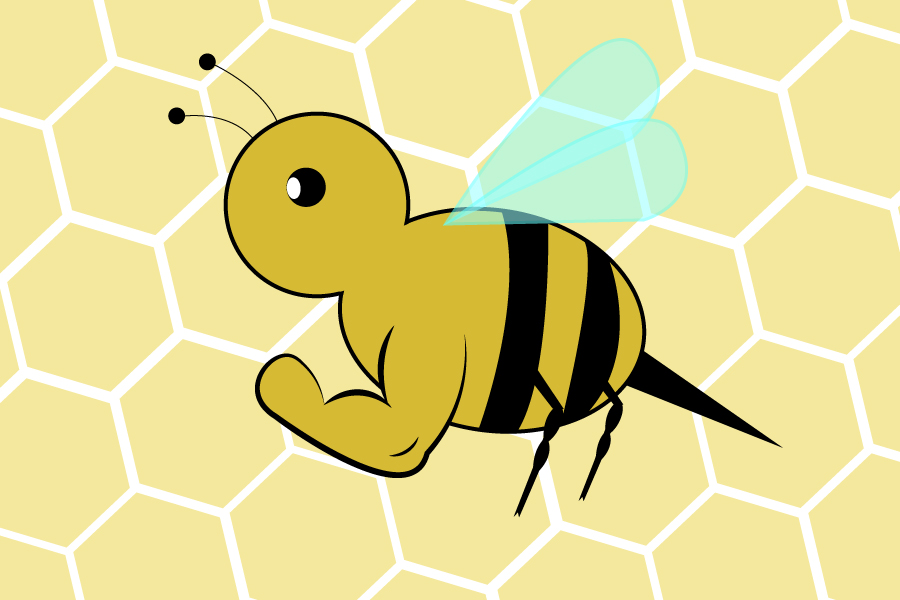
Population genetics, farming practices can create healthier, hardier honey bee
Health and honey go hand in hand. It is often suggested that those who suffer allergies eat wildflower honey from local bees. Honey can also kill various bacteria, such as Escherichia coli. But we often don’t think about the health of honey bees, the producers of that honey.
A recent study done by the Ramirez Lab at UC Davis in the Department of Evolution and Ecology brings this question to light. The study looked at the population distribution of different types of honey bees, or apis mellifera, in California since the species first introduction to the state in 1863. Numerous lineages have emerged; the two prominent ones are the M group, which includes a. mellifera, more commonly known as the European honey bee, and the A group, which includes a. mellifera scutellata, or the African honey bee. But there are more groups, such as the C, which includes italian a. mellifera, or the Italian honey bee.
Looking at specimens from museum collections, the research was able to map out the species’ evolution and genetic distribution over the past 105 years. Significantly, they found that the honey bee population in southern California stems from the A lineage of the African honey bee. While notorious for its aggressive behaviour, this lineage is of increasing interest. Earlier research has shown that the African honey bee is more resistant than others to the varroa mite, a parasite to which the honey bee is highly susceptible.
“It is a small mite that can attack adult mellifera and can transmit viruses,” said Santiago Ramirez, an assistant professor of evolution and ecology and one of the lead researchers of the study. “This is by far the most important cause of mortality of the honey bee in the U.S.”
A single infected bee can affect the whole colony, as the infected may transfer the viruses and weaken the colony overall. Unfortunately, varroa mites are everywhere. As a farmer in the United States, dealing with issues related to varroa mites is unavoidable, explained Ramirez. A farmer is forced to kill them, weaken them, or wait for winter, when the mite colonies die off.
However, if all the agricultural honey bees are Africanized, or bred with the African honey bee, it is possible that a stronger, healthier honey bee may be created that is more resistant to the varroa mite, as suggested by Ramirez.
But mites are not the only problem that honey bees face.
Honey bees are currently the primary pollinator used by farmers in large-scale crop production. In industrialized agriculture, you can think of them as a type of mono-pollinator.
“Honey bees are by far the most widely used pollinator, because they have very large colonies and can be deployed in large numbers in large agricultural crops,” Ramirez said. “There is a convenience to honey bees.”
This places a lot of stress and dependence on a single pollinator species. Moreover, it exposes honey bees to factors that compromise their health.
“The honey bee has survivorship issues relating to various pathogens and parasites in industrial agriculture,” said Brian Johnson, a professor of agricultural entomology and bees at UC Davis.
While a more genetically resistant bee could be the solution to the threat posed by these pathogens and parasites, Johnson does not believe it is the answer.
“Bee breeding has been and will be less effective a means of ensuring the health and productivity of honey bees than is the production of better treatments for the parasites that abound in them,” Johnson said.
One way to address this threat to the honey bee is in providing greater diversity in pollinators for farming. Johnson noted that the exclusive use of honey bees only makes sense in an agricultural model that prioritizes productivity and economic output. Such a model does not take into consideration the health of the ecosystem and its operating components, like the honey bee as a pollinator.
“There are definitely drawbacks to using them as a main pollinator when the species is already suffering from high mortality rates,” Ramirez said.
For a healthier and hardier honey bee, the question is not only how to make a honey bee more resistant to certain pathogens and parasites, like the varroa mite, but how we can improve pollination practices in industrial farming. It might not only make for a healthier honey bee, but a healthier ecosystem overall.
And there are things students and families can do to help honey bees, as Christine Casey, the academic program management officer at the Häagen-Dazs Honey Bee Haven, explained.
“The take-home message for the campus community is that no matter the bee species, access to adequate, nutritious food — flowers — is essential for bee health,” Casey said. “While an extensive bee garden is great, even a single sunflower in a pot on your front porch is great for bees.”
Written by: Matt Marcure — science@theaggie.org



